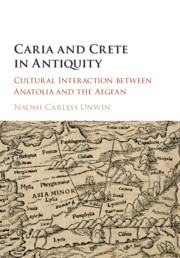Book contents
- Caria and Crete in Antiquity
- Caria and Crete in Antiquity
- Copyright page
- Dedication
- Contents
- Figures
- Maps
- Preface
- A Note on Transliteration and Translation
- Abbreviations
- Introduction: Approaching the Topic of Carian–Cretan Interaction
- 1 Articulating a ‘Carian’ Identity
- 2 The Role of Crete in the Mythologies, Local Histories and Cults of Caria
- 3 The Case of Miletos: Archaeology and Mythology
- 4 Interaction and the Reception of the Cretan Connection during the Hellenistic Period
- 5 Inscribing History at Magnesia-on-the-Maeander: Civic Engagement with the Past
- 6 A ‘Cretan-Born’ Zeus in Caria: Religious Mobility between Caria and Crete
- Concluding Remarks
- Book part
- References
- Index
- References
References
Published online by Cambridge University Press: 13 July 2017
- Caria and Crete in Antiquity
- Caria and Crete in Antiquity
- Copyright page
- Dedication
- Contents
- Figures
- Maps
- Preface
- A Note on Transliteration and Translation
- Abbreviations
- Introduction: Approaching the Topic of Carian–Cretan Interaction
- 1 Articulating a ‘Carian’ Identity
- 2 The Role of Crete in the Mythologies, Local Histories and Cults of Caria
- 3 The Case of Miletos: Archaeology and Mythology
- 4 Interaction and the Reception of the Cretan Connection during the Hellenistic Period
- 5 Inscribing History at Magnesia-on-the-Maeander: Civic Engagement with the Past
- 6 A ‘Cretan-Born’ Zeus in Caria: Religious Mobility between Caria and Crete
- Concluding Remarks
- Book part
- References
- Index
- References
- Type
- Chapter
- Information
- Caria and Crete in AntiquityCultural Interaction between Anatolia and the Aegean, pp. 231 - 257Publisher: Cambridge University PressPrint publication year: 2017



